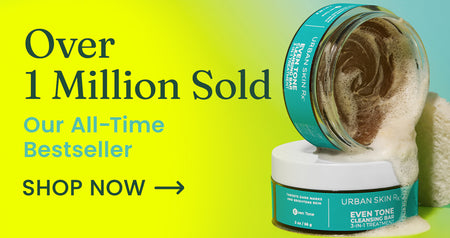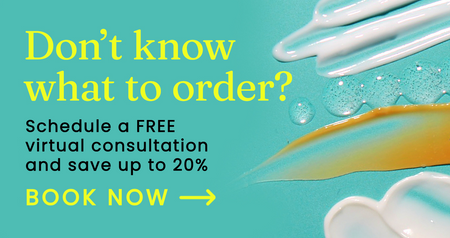Our Complete Guide on How To Get Rid of Acne Scars

We thought the worst of our skincare problems peaked at the same time as our teenage enemy — high school.
While many things contribute to whether or not you have acne, it’s most common and most annoying in your teenage years. That’s because when your hormones are running amok throughout puberty and causing you to cry over some boy who wears the same pair of sweatpants to school every day, they’re also impacting your skin!
Unfortunately, even if you’ve long since gotten a grip on your love life and your skincare routine, acne can have lasting effects. Namely: acne scars.
Luckily, you don’t have to live with these little reminders of rougher, redder days forever — there are many ways in which you can reduce or even get rid of acne scars, no matter how bad they might be. But first...
What Causes Acne Scars?
While acne scars only really cause cosmetic damage, they can be a real source of distress if you have them. Some people are just more prone to acne scars than others — in the same way that some people are more prone to acne than others.
So while there are some steps you can take to decrease the likelihood that your acne will have a lasting impact on your complexion, it’s partly up to chance and genetics.
That said, there are a couple of things that are more likely to cause acne scars in the long run.
The main one is picking or squeezing your acne as opposed to just allowing it to heal, or treating it appropriately. When a breakout is the only thing standing between you and the glorious glow you know you’re capable of, trying to pop your pimples out of existence is so, so tempting. But it’s important to resist!
How Do You Prevent Acne Scars?
In addition to not picking at your skin, a solid, dependable skincare regimen will go a long way to keeping your skin happy and bright. This is the easiest way to avoid acne scars: by avoiding acne!
And while you can’t go back in time and tell your teenage self with her hands full of heavy, cakey foundation to put it down and try an exfoliant, you can take some steps to ensure that you learn from your mistakes.
Skincare regimens can get complicated quickly, so if you’re looking for something simple and low-maintenance to keep your acne in check, there are a few key points we’d recommend hitting.
1. Wash Your Face
This seems obvious, but there’s an art to face washing, and it basically boils down to listening to your skin! While we strongly recommend washing your face twice a day, especially if you live in a place with a lot of air pollution or wear heavy makeup, it’s important to take note of how your skin reacts to changes in your routine.
If you’re washing your face so much that it’s becoming dry, tight, irritated or flaky, you’re washing too much and stripping your skin of essential moisture. Sometimes, even if you’re only washing your face in the morning and in the evening, it might be too much if you have sensitive skin. However, if you can’t imagine waking up or going to sleep without washing, don’t worry — there are options!
You can either dial back your use of facewash to the evenings when you remove your makeup and the grime of the day, and simply cleanse your skin with water in the morning to feel fresh. Or you could try a cleanser that is focused on moisturizing your skin.
We love Lacticglow Micropolish Resurface and Brighten Cleanser if you’re struggling with dryness after washing your face. It’s a great way to give you the clean feeling you love while allowing your skin to retain the moisture it needs to glow.
2. Exfoliate
An often skipped but super beneficial step in your skincare routine, exfoliating is a great add to your regimen if you’re trying to avoid breakouts. A detoxing face mask and scrub — especially one as seasonally delicious as our Purifying 2-in-1 Pumpkin Pore Detox Mask and Scrub — will go a long way toward keeping your skin clear.
3. Use SPF
Protecting your skin from the sun is crucial for many reasons, not the least of which is that it helps to reduce the appearance of acne scars and avoids exacerbating sensitive skin caused by acne.
Our Complexion Protection Moisturizer SPF 30 is a great go-to for the day-to-day. If you’re worried that adding an SPF will worsen your skin if it’s oily, have no fear: ShineBlock™ Oil Control Moisturizer SPF 30 is a great option to keep your skin protected from all the bad kinds of shine, sun or otherwise.
Are There Different Types of Acne Scarring?
Yes! And recognizing the kind of scarring you experience is an important step of figuring out how best to treat it. There are a few different categories of acne scarring, which is a niche bit of information you never knew you needed.
Atrophic Acne Scars
Atrophic acne scars are probably what most of us picture when we hear “acne scars.” They tend to be a bit more difficult to clear up than other types — but definitely not impossible!
Under the atrophic umbrella, you have boxcar scars, ice pick scars and rolling scars. They all present slightly differently, but overall they’re often the result of more serious cases of acne, such as cystic. They can also be the result of a disease that impacts your skin, such as chickenpox or varicella.
Atrophic scars present as depressions or indentations that may make skin appear wavy and uneven.
Hypertrophic and Keloid Scars
Hypertrophic and keloid scars look a bit different. Rather than being depressions or indentations in the skin, these kinds of acne scarring tend to be raised clusters of built-up scar tissue. They tend to be more common in people with darker complexions, and mostly appear around your jaw, chest, back or shoulders — which… seriously? As if back-ne wasn’t frustrating enough…
Post-Inflammatory Hyperpigmentation
Not that we have a favorite type of acne scar, but this may be our favorite type of acne scar because it tends to be temporary. That’s because it’s not truly a scar — it’s just discoloration of the skin that may occur after you conquer some pretty severe acne or the distress caused to your skin by picking at your acne.
You don’t necessarily need to treat post-inflammatory hyperpigmentation, even if you want it to go away — but we’ll still make a few recommendations as to how to best pamper your skin after doing battle with your blackheads.
How Do You Get Rid of Scars?
Whether you ended up with acne scars because your teenage self wasn’t the glam goddess with an arsenal of skincare know-how you are now, or because you’re just predisposed to it, there are many options for reducing or resolving the appearance of acne scars.
1. Microneedling
Microneedling is exactly what it sounds like! A licensed aesthetician pricks your skin with tiny, tiny needles to stimulate collagen production. This makes for a smoother complexion overall, and also readies your skin to better absorb any topical treatments you might apply. For this reason, we recommend pairing it with…
2. Skincare Products that Include Bakuchiol
Bakuchiol boasts similar benefits to the much-discussed Retinol, but it’s gentler on your skin, and plant-based, so it’s ideal if you pay attention to what you put in or on your body. Using something like Reti-Glow Gentle Resurfacing Night Oil before you go to sleep is a great, low-effort way to help reduce blemish scars.
We also offer our Advanced Even Tone Day and Night Treatment that can be used on its own or with a moisturizer. Bakuchiol will need to be applied regularly to see results, but once you do, you’ll wonder why people even use Instagram filters when your face just sparkles on its own. It’s best to moisturize after using this treatment to help keep your skin happy and hydrated.
3. Facial Fillers
The word “filler” can be scary if you’re for whatever reason averse to plastic surgery, but it’s actually a relatively straightforward procedure that can have almost immediate effects. It also works long term and most patients are satisfied with their facial fillers even five years after treatment!
Facial fillers like Bellafill just supplement your face with collagen to add volume to your skin and add structural support where your acne scars may have damaged it. There are other types of fillers, too, such as Hyaluronic Acid or Poly-l-lactic Acid, but it’s best to discuss which option is for you with a licensed professional. If you’re looking for quick, long-term results, and don’t mind breaking the bank a little bit, facial fillers are an easy option.
Conclusion
The easiest way to handle acne scars is to work hard to prevent them in the first place, especially if you’re prone to acne. Once you have them, though, there are still many options to help restore your skin to its fullest, smoothest glory.
That said, we think it’s important to note that your face is your face. There isn’t another like it, and it’s things like scars and freckles and marks that make us all unique — while we’re totally here for you with a rundown on how to treat and avoid acne scars if that’s what will make you happiest and most comfortable, we think you’re beautiful however you feel the most you.



